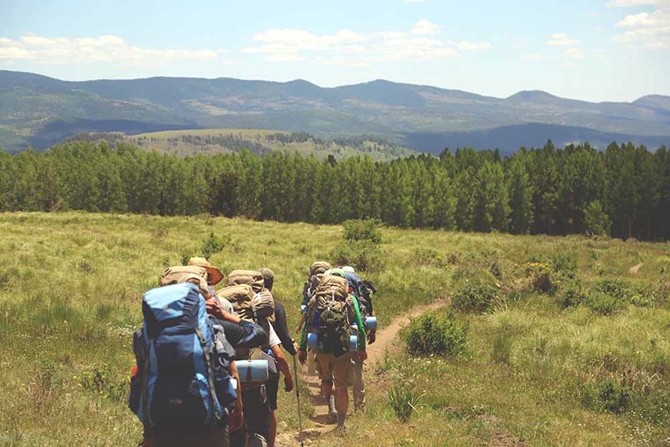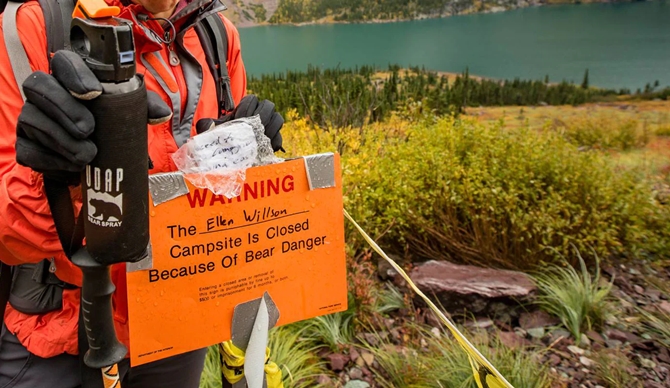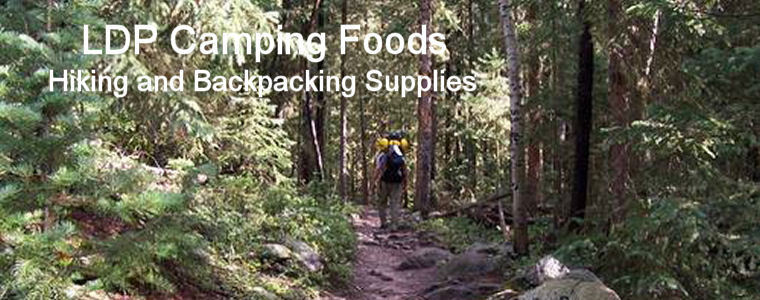Bear Country 101
For more than a few hikers and campers in Canada and the USA, there’s no
greater fear than an encounter with a bear. Bears are the classic bogeymen
of the North American wilds: the go-to explanation for any thump in the
night outside the tent or crash in the underbrush along the trail.
The danger they pose, however, is vastly overrated, and every outdoorsperson
should appreciate the ecological value and brawny spirit represented by
these intelligent, resourceful beasts. Your average bear will normally go
out of its way to avoid a run-in with a human being. Many bad bear/human
encounters boil down to disrespect, negligence, or sheer unawareness on our
part.
That’s an indictment—and also an encouragement! There’s a lot you can do to
decrease the odds you’ll have a nasty confrontation with a bear. In this
blogpost, we’ll tick off some fundamentals of bear safety while camping and
hiking.
After all, it may be wintertime now, but it won’t be too long before black
and grizzly bears across the continent will be shoving their groggy mugs
from their dens and swaggering out for a brand-new season of slurping ants
and berries, crunching acorns and pine nuts, and—maybe—crossing paths with
hikers on forest and mountain trails. What better time to review a bear
safety guide?
The Bears of North America: A Quick Introduction
North America harbors three of the world’s bear species. The polar
bear rules the sea ice and coastal tundra of northern Alaska and
Canada. It’s a different-enough creature—more carnivore than omnivore, more
predator than forager, more marine mammal than terrestrial one, and an
animal not often encountered by most outdoorspeople given its
top-of-the-world range—that we won’t be including polar-bear safety tips in
this here roundup. (But if you are headed for “ice-bear” country,
check out these safety primers from Parks
Canada and the U.S.
Fish & Wildlife Service.)
From Arctic tundra south down the Rocky Mountain spine to the Greater
Yellowstone, meanwhile, the grizzly bear—a North American
subspecies of the brown bear, also widespread in Eurasia—reigns. (in the
southern Alaska’s Kodiak Archipelago lives another brown-bear subspecies,
the biggest in the world in fact: the Kodiak bear.) Finally, the American
black bear—by far the most numerous and widespread of the
continent’s bruins—occupies most of the USA and Canada, including large
portions of the East where it's the only bear.
Long story short, most of North America is bear country, and in many of its
most popular outdoor destinations you’ll be sharing space with these giant
omnivores: It pays to learn the basics of bear etiquette and safety!
The Risk
Being attacked by a bear (whether black, grizzly, or polar) is a genuinely
terrifying prospect, but in reality it’s a rare occurrence. Between 2001 and
2013, an average
of one fatal bear attack per year occurred in the United States.
Grizzlies tend to be more dangerous and aggressive than black bears, but the
latter overlap more extensively with people.
Yellowstone National Park puts the risk of a grizzly attack in
context: It’s one in every 2.7 million visits when all park
activities are considered together. People who camp in front-country
campgrounds have about a one in 22.8 million chance of being attacked by a
grizzly; the risk is significantly higher for backpackers—one in 1.4
million—but all things considered that's still low.
Bear Safety While Backpacking: On The Trail
When it comes to bears, there’s safety in numbers: Groups of three or more
hikers are rarely attacked. That’s surely at least partly because larger
parties make more noise on the trail than one or two people, lessening the
odds of a surprise encounter with a bear.
And surprise encounters are the leading setup for dangerous bear situations.
We’ve already established that most bears would rather steer entirely clear
of human beings, but when a person abruptly appears at close range without
warning, some will defensively charge or even attack—though even in sudden,
close-range run-ins, a lot of bears still favor the flight option of
fight-or-flight.(And, on this point, a heads-up to you mountain bikers:
Pedaling on backwoods trails may make you especially
vulnerable to bears, as the mode of travel is fast and quiet.
Bears may not hear you coming, and will have less time to react.)

Making Noise: Are Bear Bells Effective?
Avoiding sudden encounters with bears means making noise while hiking so
that, hopefully, they hear you coming in time to exit the scene.
Intentionally being noisy can be an annoying challenge for many
outdoorspeople who head for the wilds for the peace and quiet, and for the
opportunity to potentially spot wildlife. And it’s true: Advertising your
presence and identity as a human being in the backcountry—one of the
fundamentals of basic bear safety—likely means you’re going to see fewer
deer, elk, foxes, and other critters. It’s a tradeoff you have to reckon
with.
It’s common, especially in grizzly country, to run into hikers on the trail
jangling with bear bells. But do these accessories actually alert bears to
your presence? Well, the jury’s sort of out, but most experts agree bear
bells probably
aren’t all that effective. Their sound doesn’t travel very far,
especially in heavy timber or wind or alongside running water. Loud talking,
shouting, and/or hand-clapping probably work better: Do so periodically on a
bear-country hike, and definitely when passing through especially vulnerable
areas such as noisy streamways or thick brush.
Assessing the Bear Hazard
Learning some very introductory ursine natural history will pay real
dividends on the trail, as it’ll help you more accurately gauge the relative
bear risk certain landscapes pose.
First off, familiarize yourself with the appearance of bear tracks and scat,
which with a little practice are actually pretty easy to distinguish. Fresh
evidence of either, as common sense would suggest, should put you on
guard—or even convince you to abort your hike, at least in that particular
area.
Key into bear foods, as they dictate (no surprise) much of a bear’s
day-to-day wanderings. Grizzlies and black bears have extremely broad and
varied diets with a lot of local and seasonal variation, but here a couple
of general notes:
-
Early in the season, you may well be likelier to run into a bear in
riparian areas and draws and on south-facing slopes—all places where
vegetation first greens up.
-
Across much of the continent, midsummer to early fall sees bears gorging
among thickets of various berry shrubs: huckleberries, thimbleberries,
buffaloberries, etc. If you’re passing through ripe berry bushes, be on
guard and make extra noise.
-
In some areas (such as coastal Alaska and B.C., and in Yellowstone),
both grizzly and black bears feast on salmon and trout during
their runs, when you’d do well to be extra careful around spawning
rivers and fishing
streams (or avoid them altogether).
If you happen to stumble upon a carcass in grizzly country, meanwhile—or if
you catch the aroma of one—leave the area immediately: You really don’t
want to be on the receiving end of a grizzly’s territorial wrath when it’s
defending a dead animal.
Bear Encounters
If you do meet a bear on the trail, remain calm: You need to assess the
situation with a clear head, not panic—which could potentially escalate a
fairly low-risk situation into something dicier.
If a bear hasn’t seen you, quietly retreat back along the trail; or, if the
animal’s far enough off (say, well up- or down slope of you), you might opt
to continue in your direction of travel. (But keep in mind that a bear
bypassed on an out-and-back hike may be encountered again—and maybe at
closer range—on your return trip.)
If a bear does appear to see you—looking alertly your way, maybe even
rearing onto its hind legs for a better view—hold your ground and talk
loudly but calmly. You want to help the animal ascertain your identity as a
person—and thus something it likely doesn’t want to tangle with—and also
establish yourself as non-threatening. Pay attention to the breeze, and if
it’s possible position yourself (slowly) upwind so the bear can scent you.
(A bear’s sense of smell is much better than its eyesight.)
At this point most bears will likely turn around and galumph away. If it
continues staring at you, showing sign neither of fleeing nor charging, try
slowly backing away—still facing it, still talking firmly and steadily.
Protocol for black bears and grizzlies differs enough that we’ll treat each
separately now as we talk about what to do if a bear encounter continues
beyond the scenarios outlined above.
Black Bear Encounters
If the bear in question is a black bear, watch its response to you
carefully. If it doesn’t run away or entirely ignore you (as habituated
black bears in popular camping or recreation areas may do), there’s a good
chance instead it will exhibit signs of discomfort or agitation at your
presence. Such a defensive bear may flatten its ears, clack its teeth, grunt
or wheeze, even paw the ground. This kind of performance can be intimidating
(heck, it’s meant to be), but if you back off, talking in a calm voice, or
go out of your way (literally) to detour around the area, the bear is
unlikely to cause you trouble. (It’s unusual even for a mother black bear
with cubs to act aggressively toward people.)
More worrisome is a black bear that approaches you, maybe tentatively at
first, with silent curiosity. On the surface, this sort of bear seems much
less threatening than the abovementioned defensive one, but the quiet,
inquisitive approach should set off warning bells: This may be a bear sizing
you up as potential prey, and statistically speaking predatory attacks by
black bears (particularly by lone males) are the most dangerous kind.
Fortunately, such attacks are not only super-rare, but also can very often
be thwarted before actual physical contact by a person responding
assertively. Shout at the bear and wave your arms; if it gets too close,
throw a stone, stick, or whatever else is available (though not your
backpack or any food items). If you have pepper spray, use it. If a bear
that’s behaved in a predatory manner does attack you, fight back—don’t play
dead.
Grizzly Bear Encounters
In contrast to black bears, most grizzly attacks are defensive in nature: a
bear defending cubs, a carcass, or simply its personal space. A grizzly is
more likely to charge you: a frightening spectacle, to be sure, though
usually just that—spectacle. Most grizzly rushes are bluff, and if you stand
your ground the bear will probably veer off before making contact. A grizzly
may make several of these charges, and running away is the worst thing you
can do: It may trigger a chase, and bears are much faster than
people—outrunning one is not an option.
Should you try climbing a tree to escape a grizzly bear? Conventional wisdom
correctly pegs a grizzly as a worse climber than a black bear, but a couple
of issues: (1) Grizzlies can make their way up a tree trunk if they
want to; (2) it’s rare that a nice, climbable tree stands close enough to
scramble up before a griz going full-speed catches up with you; and (3) are
you really that great of a tree-climber?
So holding your ground’s the best bet. If a grizzly looks like it’ll
actually hit you, use that pepper spray you’ve got ready at hand (see
below). If that doesn’t work and the grizzly attacks, get down on your
stomach, put your hands behind your neck, and play dead. The bear will
likely bite and swat you a little, then leave you be, satisfied the threat
it was responding to has been neutralized. (If the grizzly's attack
continues beyond a couple of minutes, start fighting back.)
The Value of Bear Spray
If you really want to cover as many of your bases as you can recreating in
bear country, you ought to carry bear-specific pepper spray. Deployed in a
cloud at close range, this capsaicin-based product aggravates a bear’s eyes,
nose, and airways, giving you time to leave the area and likely discouraging
the animal from pursuing an attack further; it's also appealing because it
doesn't result in lasting injuries to the bear. Bear spray can be very
effective when used correctly: A 2008
study analyzing more than 80 cases in Alaska showed it deterred
brown bears 92% of the time, black bears 90% of the time, and polar bears
100% of the time (only two polar-bear incidents were reviewed).
To learn the proper use of bear spray, check out this
page from Yellowstone National Park, which includes a
demonstration video. Remember: Make sure the canister you’re carrying hasn’t
expired, keep it in an easily accessible belt holster (not buried in your
backpack), and don’t blast that spray into the wind!

Bear Safety While Camping
Camping in bear country demands its own set of responsible behaviors on your
part, as a poorly executed campsite can actually be a bear attractant.
Bears, after all, possess a mean sense of smell and an omnivore’s non-picky
foraging habits, so the onus is on you to keep a clean camp and carefully
manage odors.
Keep your cooking/eating and sleeping areas separate. Prepare and eat meals
at least 100 yards downwind of your campsite. In bad or cold weather, it’s
tempting to make food at the tent, but avoid the temptation unless
conditions are truly awful. In Bear
Attacks: Their Causes & Avoidance (recommended reading for
any outdoorsperson), Dr. Stephen Herrero suggests that those who engage in
both summer and winter camping ought to think about dedicating separate
tents for each: There’s a decent chance you will be cooking and
eating in your tent during the winter—when you have to less to worry about
from the ursine crowd—and you don’t necessarily want to sleep among those
food odors come summer.
Don’t bring food, garbage, or toiletries into the tent. Store these items in
a bear bag or bear canister. (Some people also change out of the clothes
they wore when cooking and eating and stow these with the other odorous
items.) Bear bags must be hung from trees (or established poles) so they’re
out of reach of bears, and there are several different methods for doing
so—all of them requiring a bit of practice, and enough daylight left when
setting up camp to identify suitable hang trees. The Leave No Trace Center
for Outdoor Ethics provides a good
how-to on hanging a bear bag; so does Backpacker and
the Alaska
Department of Natural Resources.
Some areas don’t have trees suitable for hanging a bear bag—or local bears
have figured out how to sabotage the system. A popular and much easier
alternative is to use a bear canister, which in some national parks
backpackers are now required to carry. These canisters are hidden on the
ground well away and downwind from your campsite. Grand Teton National Park
(one of the places requiring the use of canisters) offers a handy
primer.
Thanks to
Mountain
House Blogs for the above information.

